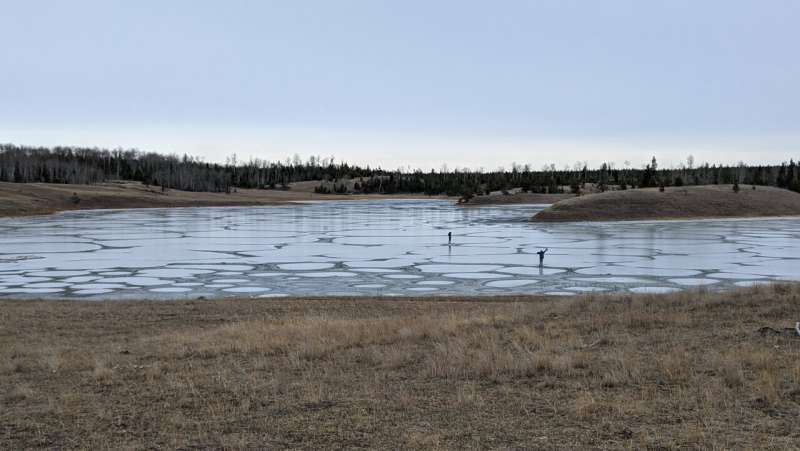Potential for Life on Earth Found in Shallow Soda Lakes

January 22, 2024
This article has been assessed in alignment with the editorial policies and process at Science X. The editors emphasize the following attributes to ensure the credibility of this article:
- fact-checked
- peer-reviewed publication
- trusted source
- proofread
by Hannah Hickey, University of Washington
Charles Darwin speculated that life could have originated from a 'warm little pond' full of the right mix of chemicals and energy. A recent study from the University of Washington, published in Communications Earth & Environment this month, hints that a shallow 'soda lake' in western Canada may fit this criterion. This research lends further evidence to the notion that life may have originated from lakes on Earth around 4 billion years ago.
It's well-established that under ideal conditions, life's complex molecules can arise spontaneously. As depicted in popular science fiction film 'Lessons in Chemistry', inorganic molecules can be stimulated to form biological molecules. Even after the real-world discovery of amino acids—the building blocks of proteins—in the 1950s, more recent studies have constructed the building blocks of RNA. However, the next progression demands incredibly high concentrations of phosphate.
Phosphate forms the 'backbone' of RNA and DNA and is also an essential component of cell membranes. The lab-specific phosphate concentrations needed to create these biomolecules are several hundreds to a million times higher than those typically found in rivers, oceans, or lakes. This disparity is often referred to as the 'phosphate problem' relating to the origin of life—a problem potentially solved by soda lakes.
Senior author and UW professor of Earth and space sciences, David Catling, believes that soda lakes may hold the solution to the phosphate problem. He expresses optimism in suggesting such environments should have been present on Earth—and possibly on other planets—as it’s a normal result of planetary surface formation and water chemistry.
The term 'soda lakes' comes from their high levels of dissolved sodium and carbonate, akin to dissolved baking soda, resulting from reactions between water and underlying volcanic rocks. Soda lakes can also contain high levels of dissolved phosphate.
Prior research at UW in 2019 theorized that life could potentially emerge in soda lakes. The researchers amalgamated chemical models with lab experiments to demonstrate that phosphate could theoretically be concentrated in these lakes to levels a million times higher than usual waters.
In their most recent study, the team studied such an environment on Earth. Conveniently, the most promising location was within driving range. The highest known natural phosphate level in scientific literature was reported from Last Chance Lake in British Columbia, Canada—an approximate seven-hour drive from Seattle.
The shallow, murky lake is located on a dirt road in British Columbia’s ranching country, on the Cariboo Plateau. Consistent with the characteristic properties of a soda lake, it is situated over volcanic basalt rock, and its water levels are regulated by a combination of a dry, windy atmosphere and water evaporation, which concentrates the dissolved compounds.
The new analysis published in the paper suggests soda lakes are a likely contender for the emergence of life on Earth and possibly other planets.
The team studied this natural environment that could exist on planets across the solar system. Since volcanic rocks are common on planetary surfaces, the study's lead author, postdoctoral researcher Sebastian Haas, believes the same water chemistry could have occurred not just on early Earth, but also early Mars and Venus, provided there was liquid water.
Between 2021-2022, the UW team visited Last Chance Lake three times to observe its varying states: frozen in winter, full during the rainy spring and snowmelt in early summer, and almost entirely dried up by late summer.
According to Haas, in spite of the dried-up lake bed, pockets of water high in dissolved phosphate were found in crevices and depressions. The aim was to understand the circumstances that could have triggered this occurrence on early Earth, potentially providing a setting for the development of life.
The team also collected water, lake sediment, and salt crust samples on all visits to better understand the chemistry of the lake.
In most lakes the dissolved phosphate quickly combines with calcium to form calcium phosphate, the insoluble material that makes up our tooth enamel. This removes phosphate from the water. But in Last Chance Lake, calcium combines with plentiful carbonate as well as magnesium to form dolomite, the same mineral that forms picturesque mountain ranges. This reaction was predicted by the previous modeling work and confirmed when dolomite was plentiful in Last Chance Lake's sediments. When calcium turns into dolomite and does not remain in the water, the phosphate lacks a bonding partner—and so its concentration rises.
'This study adds to growing evidence that evaporative soda lakes are environments meeting the requirements for origin-of-life chemistry by accumulating key ingredients at high concentrations,' Catling said.
The study also compared Last Chance Lake with Goodenough Lake, a roughly three-foot-deep lake with clearer water and different chemistry just a two-minute walk away, to learn what makes Last Chance Lake unique. The researchers wondered why life, present in all modern lakes at some level, was not using up the phosphate in Last Chance Lake.
Goodenough Lake has mats of cyanobacteria that extract or 'fix' nitrogen gas from the air. Cyanobacteria, like all other lifeforms, also require phosphate—and its growing population consumes some of that lake water's phosphate supply. But Last Chance Lake is so salty that it inhibits living things that do the energy-intensive work of fixing atmospheric nitrogen. Last Chance Lake harbors some algae but has insufficient available nitrogen to host more life, allowing phosphate to accumulate. This also makes it a better analog for a lifeless Earth.
'These new findings will help inform origin-of-life researchers who are either replicating these reactions in the lab or are looking for potentially habitable environments on other planets,' Catling said.
Journal information: Communications Earth & Environment
Provided by University of Washington




